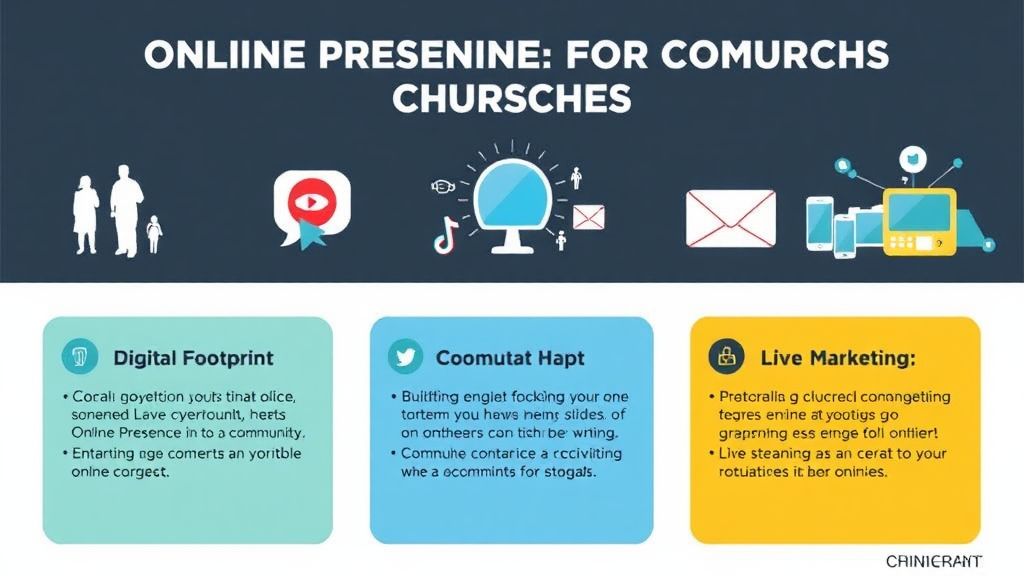In the digital age, having a strong online presence is critical for churches to connect with their congregation and attract new members. As more individuals turn to the internet for information, churches must engage online to foster relationships and spread their message effectively. Here are the top five tips for improving your church’s online presence to create a vibrant digital community.
Key Takeaways
- Essential Online Presence: Establishing a website and social media accounts is vital for information sharing and community building.
- Engaging Content Creation: Regularly updating content through blogs, videos, and podcasts can deepen connection with followers.
- Community Building: Engaging with followers through social media, events, and testimonials fosters community spirit.
- Email Marketing and Online Giving: Use email tools to keep the congregation informed and provide easy online giving options to streamline support.
- Leverage Live Streaming Technology: Live streams of services and events can expand reach and maintain connection with those unable to attend in person.
If you're looking for professional help to boost your church's online presence, connect with us at ipsom.io!
1. Harness the Power of Social Media
Utilizing social media is a game changer for churches aiming to connect with their congregation. Establishing accounts on platforms such as Facebook, Instagram, and Twitter can enhance your outreach. Each platform has unique demographics, so tailor your posts to align with your audience's preferences. This focused strategy leads to better engagement and fosters genuine community involvement.
Establishing Social Media Accounts
Creating accounts on major platforms allows for effective communication. Each social media site serves a different purpose and audience. Facebook is ideal for community announcements, Instagram for visual storytelling, and Twitter for real-time updates. By utilizing these platforms, your church increases visibility and creates an inviting online presence.
Content Strategies for Social Media
To deepen engagement, create a mix of content types. Use personal stories, announcements, and fun facts, coupled with high-quality images and videos. Visual content is more likely to grab attention, fostering interactions. Encourage community participation by posting prayer requests and sharing testimonials. This interactive approach cultivates a sense of belonging among members.
Building Community Online
Active engagement with your online audience is essential. Respond promptly to comments and inquiries to show you value their input. Collaborating with other local churches or organizations can boost visibility while reinforcing community spirit. This effort not only strengthens relationships but also broadens your outreach, drawing in more individuals interested in joining your church community.
Utilize Email Marketing
Email marketing is an essential tool for churches to keep their congregation informed and engaged. Here are some key points:
- Keep Congregation Informed: Regular newsletters share important updates, inspiring messages, and upcoming events.
- Preferred Communication Method: Studies show that 47% of people prefer to receive promotional content via email, making it an effective outreach channel.
Importance of Email Engagement
- Stay Connected: Regular newsletters ensure congregation members are updated on church events and news.
- Community Building: Consistent communication fosters a sense of community, encouraging active participation and attendance.
Effective Email List Management
- Segment Your Audience: Manage your email list by segmenting based on demographics and involvement levels.
- Tailored Messaging: Customize messages for different groups to increase relevance and engagement.
- Personalization: Strengthen connections by addressing members by name and including specific information about their activities.
- Higher Open Rates: Personalized content can lead to higher open rates and better engagement.
Tracking and Refining Email Strategies
- Monitor Engagement Metrics: Use tools to track open rates, click-through rates, and other key indicators to assess performance.
- A/B Testing: Experiment with subject lines and content types to optimize your emails.
- Regular Analysis: Continuously analyze your strategies to adapt and improve your approach, ensuring your messages resonate with the audience consistently.
3. Optimize Your Church Website
A well-optimized church website serves as the central hub for information and community engagement. Designing a user-friendly experience is key. Your website should reflect the church’s identity through its visuals and content. Ensure it is mobile-friendly since over 50% of web traffic comes from mobile devices, creating a seamless experience for all users.
Designing a User-Friendly Experience
Make navigation intuitive, allowing visitors to find information easily. Use a clean layout with distinguishable menu categories. A visually appealing design not only draws visitors in but keeps them engaged. Consistent branding across the website reinforces your church’s identity, making it instantly recognizable.
Content Organization and SEO
Organize content clearly to guide users efficiently. Implement on-page SEO best practices, including relevant keywords, meta descriptions, and heading tags. Regular updates to content can boost your site’s visibility in search engines. Websites that frequently share fresh content see an increase of up to 40% in organic traffic.
Regular Content Updates
Frequently share current events, sermons, and community stories. This keeps your audience informed and encourages return visits. Consider setting a schedule for regular updates, such as a weekly sermon posting or monthly event highlight. Providing valuable and relevant content helps build a loyal community online.
Learn more about effective web design techniques here!
4. Create Exclusive Online Content
Creating exclusive online content is essential for engaging your church's audience and strengthening the digital community. It offers unique resources that deepen connections and encourage active participation. By diversifying the types of content you provide, you can cater to various preferences within your congregation.
Offering Unique Digital Resources
Recording and sharing sermons, Bible studies, and special church events on platforms like YouTube or Vimeo allows members to access content at their convenience. This flexibility increases engagement and reinforces teachings from services. Starting a podcast focused on relevant faith-related discussions can further establish your church as a thought leader. Data shows that podcasts have a growing audience, with over 50% of the US population listening to them regularly.
Engaging Blog Content
An active blog can serve as a platform for sharing insights, personal experiences, and thought-provoking articles that align with your church's mission. Regularly publishing relevant content not only helps you stay connected with your audience but also improves your website's SEO. Aim for at least one detailed post per week to keep your community informed and engaged.
Diversifying Content Formats
Utilizing varied content forms—such as videos, blogs, and podcasts—caters to different audience preferences. Research indicates that 65% of people are visual learners, making video content particularly impactful. By providing a mix of engaging materials, you can maintain the interest of your congregation while promoting deeper understanding and connection to the church's values and teachings.
5. Implement Online Giving Options
Implementing online giving options is critical for modern churches aiming to streamline donations and expand support. A streamlined donation process allows congregants to give easily during services or any time they feel inspired. Providing multiple avenues for giving encourages regular contributions and strengthens community connections.
Streamlined Donation Processes
To facilitate online giving, churches should offer options for both one-time and recurring contributions. Utilizing reputable platforms like Tithe.ly or Pushpay ensures secure transactions and reliability. Ensuring the donation process is simple and user-friendly will encourage more members to participate and support church initiatives financially.
Promoting Online Giving
Active promotion of online giving is essential for maximizing participation. Announce new online giving options through newsletters, social media posts, and during church services. Embed donation forms directly on the church website to allow for easy access. Clear calls to action, such as "Give Now" buttons, will encourage congregants to engage.
Acknowledgement and Gratitude
After receiving donations, it is important to express appreciation. Automatically thanking donors through personalized messages fosters a sense of community and recognition. This gratitude can significantly impact continued support and enhance donor relationships. Establishing a culture of acknowledgment reinforces the value of contributions and encourages long-term giving.
For more information on implementing online giving platforms, visit ipsom.io.
6. Leverage the Power of Live Streaming
- Live Streaming: An essential tool for churches to connect with congregants who cannot attend in person.
- Opportunities for Community: Provides a sense of belonging and connection among members.
- Platforms to Use: Utilize Facebook Live and YouTube Live to expand reach and engagement.
Importance of Live Streaming Services
- Fostering Engagement: Live streaming is crucial for enhancing interaction with your congregation.
- User Preference: Over 80% of internet users prefer watching live video over reading a blog post.
- Increased Visibility: Incorporating live streaming can significantly enhance your church's outreach.
- Scheduled Live Streams: Create anticipation within the congregation and encourage more viewers to tune in regularly.
Ensuring Quality Presentation
- Invest in Quality Equipment: Use high-quality cameras, microphones, and lighting to enhance viewing experience.
- Stable Internet Connection: Ensure a reliable internet connection to avoid interruptions during streaming.
- Promotion Across Channels:
- Use social media
- Send out email newsletters
- Update the church website
- Establish a Consistent Schedule: Let followers know when to connect for live streams.
Interaction During Live Streams
- Real-Time Engagement: Encourage comments and questions to create an interactive experience.
- Assign a Moderator: Have a dedicated person to respond to comments and help foster connection.
- Build Community: Engaging with viewers increases their emotional investment and sense of belonging within the church, reinforcing their bond to the community.
FAQ
Why is an online presence important for churches?
An online presence is vital for churches to connect with both current members and potential visitors. Key benefits include:
- Digital Footprint: Helps share the church's mission, events, and community activities.
- Effective Communication: Enhances outreach beyond physical locations.
- Engagement Opportunities: Fosters community connection and growth.
How can churches effectively use social media?
Churches can leverage social media by:
- Establishing accounts on popular platforms like Facebook, Instagram, and Twitter.
- Posting a mix of inspirational content, event announcements, and community stories.
- Engaging with followers:
- Responding to comments
- Collaborating with local organizations
What type of content should churches create for online engagement?
To capture online engagement, churches should create diverse content types, such as:
- Sermons and Bible studies
- Testimonials from members
- Blogging about relevant topics
- Utilizing videos, podcasts, and high-quality images to cater to different audience preferences.
How can email marketing benefit a church community?
Email marketing is an effective tool for churches to:
- Keep the congregation informed about events and news.
- Share inspirational content through regular newsletters.
- Segment email lists for targeted communication to resonate with unique demographics.
How do I set up an online giving platform for my church?
To set up an online giving platform, consider the following steps:
- Select a reputable payment processor specializing in church donations.
- Integrate giving forms on the church website.
- Promote online giving options through newsletters and services.
- Facilitate easy methods for both one-time and recurring donations.
What equipment do I need for successful live streaming?
For effective live streaming, churches typically need:
- A high-definition camera
- A microphone for clear audio
- A strong internet connection
- Additional accessories such as tripods and lighting to enhance quality.
How often should we update our church's website and social media?
- Website: Update regularly, ideally on a weekly basis to keep content fresh.
- Social Media: Update more frequently, with several posts per week to engage followers and maintain interest.
What are some effective strategies for building an online community?
Building an online community requires:
- Active Engagement: Regular interaction on social media and emails.
- Hosting virtual events and responding promptly to comments.
- Creating content that encourages interaction and collaboration with other community organizations.
- Encouraging member involvement through digital initiatives to nurture a vibrant online community.




